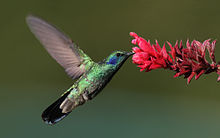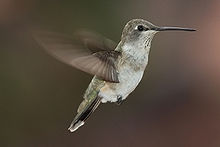Creating a garden to attract hummingbirds is very easy and a lot of fun. East of the Mississippi River the Ruby-Throated hummingbird is the only resident hummingbird; other types are called ‘accidentals.’ You may not know this but hummingbirds are important pollinators in our gardens. Hummingbirds are attracted to colorful flowers, particularly red flowers, with tubular shaped blooms such as our native honeysuckle Lonicera sempervirens, Heuchera coral bells, Penstemon beard tongue, Aquilegia canadense columbine, and Monarda bee balm. Some other perennial favorite nectar sources are Oenothera evening primrose, Veronia noveboracensis ironweed and Phlox paniculata summer phlox. One of their favorite perennials is Lobelia cardinalis Cardinal flower with its dark red flowers that hummingbirds are known to fight over.
Hummingbirds use trees for nesting and cover so be sure to include the following native trees in your landscape Fagus grandiflora beech, Betula nigra river birch, Tsuga canadensis eastern hemlock, Liriodendron tulipfera Tulip poplar, Quercus oaks and Acer rubrum maple. The understory tree Cornus florida dogwood serves as shelter and perching but also provides nectar when it is in bloom. Also, shrubs such as Viburnum dentatum arrowwood viburnum and Cephalanthus occidentalis buttonbush provide nectar and shelter or cover.
If you have a small outdoor space — from a large garden to a hanging basket on a balcony — simply add a beautiful hanging basket of colorful annuals, such as Fuchsia, Petunias, Lantana, Verbena or Geraniums. Any space that you have to offer will be used by hummingbirds.
Adding a hummingbird feeder to your garden will give you hours of enjoyment. You can watch from inside your house or even from a screened-in porch. Hummingbirds sometimes become so accustomed to non-threatening people, that they will visit a feeder near a patio while you sit quietly. Select a glass feeder because they are easiest to keep clean. A perch style feeder will allow the hummer to stop and drink. The hummingbird sugar water recipe is 1 cup sugar to 4 cups water. Boil water so the sugar dissolves completely and let cool. Do not use artificial colorings, honey or artificial sweeteners. Honey has spores that are toxic to hummingbirds, while artificial sweeteners do not give the hummingbird the needed energy. Keep feeder clean and in hot weather (over 90 degrees) clean the feeder every 2 days. Below that temperature, clean it 2 times a week and below 65 once a week. You can add sugar water in between cleanings, but In hot weather it is best to not fill feeder completely full and just add a little at a time keeping mixture fresh in the refrigerator. Creating a hummingbird habitat will give you lots of enjoyment and the hummingbirds will return year after year. Try to keep your feeder up until mid October so migrating hummingbirds can stop for a drink from your feeder on their way flying south.
Robyn Affron
Unity Church Hill Nursery
Check out the vimeo link below for a ruby-throated humming bird video






Write a Letter to the Editor on this Article
We encourage readers to offer their point of view on this article by submitting the following form. Editing is sometimes necessary and is done at the discretion of the editorial staff.